The Forts of Verdun
By
Robert E. Duchesneau
Part I - Introduction
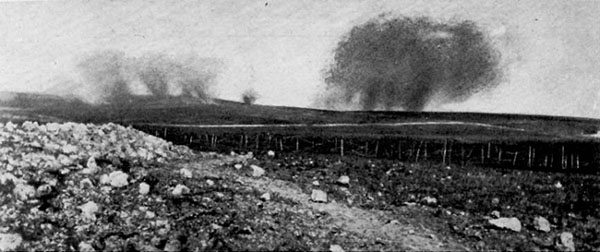
Artillery impacts on the Mort-Homme ridge at Verdun.
The Battle of Verdun was one of the bloodiest armed clashes in history. Really more of a campaign than a battle, it lasted from February to December of 1916, killing and wounding hundreds of thousands of men on both sides. Due to the nature of the battle, even approximate figures are difficult to determine, but the total killed, wounded, and missing were roughly 500,000 French and 430,000 Germans. It should be noted that the French army included numerous contingents from their colonies, notably Algeria, Morocco, and Senegal, as well as the multi-national Foreign Legion. The front over which the campaign was fought measured only 20 miles long, with the deepest German penetration being six miles.
Much of the action was centered around two forts, Fort Douaumont and Fort Vaux. I shall begin by describing their locations, then the forts themselves.
Verdun is a medium-sized city in eastern France. The Meuse River flows northward through the city. On the right bank a series of three concentric ridges partially encircles the city.
In the early 1880's, a series of forts was constructed on these ridges, particularly to the northeast of the town.
Fort Douaumont was the northeasternmost of these, with Fort Vaux a couple of miles to the south. A defense in depth of several other forts was provided in the area.
On the left bank, a long east-west ridge known as the Mort-Homme (Dead Man) lies to the northwest of Verdun. Forts existed on this ridge as well. The ridge's name may derive from its shape, which may resemble a man lying on the ground from some angles. I would appreciate any information a reader may have on this subject.
The forts of Verdun were constructed in the early 1880's. They were part of an extensive system designed by the noted engineer General Sere de Rivieres, whose task was to protect
France from a repetition of the disastrous Franco-Prussian War of 1870. In this war, France had been overrun in six weeks, and the Emperor Napoleon III captured. France was occupied by the Germans until she paid an indemnity of $2 billion (back then, this was serious money) and surrendered the provinces of Alsace
and Lorraine. To prevent further German incursions, Sere de Rivieres designed and constructed fortified zones around strategically located cities. Verdun was among the strongest of these, with 19 forts and 9 smaller "ouvrages" (works). Some forts formed a circle around the city, allowing it to accept siege if need be. Additional forts were placed to the north
and east, where it was anticipated an attack would (and did) come.
Fort Douaumont was a fort of the largest type in the system.
Like all French forts, it was named for the nearest village.
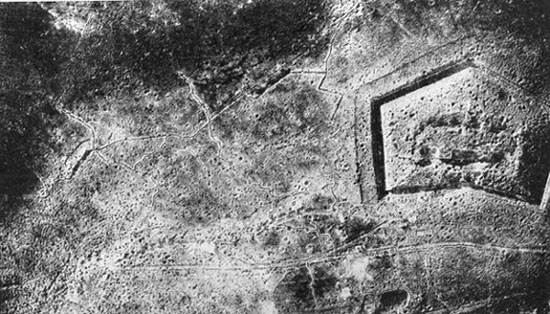
Ft. Douaumont during the battle. Note the numerous shell craters.
(A modern aerial view of the fort is at Patrik's Verdun Site, under "Something I'm Really Proud Of".) A wide, deep pentagonal concrete ditch surrounded it, with the point toward the anticipated enemy, roughly north. The entrance was at the rear. Two main tunnels ran east-west, one above the other, beneath a roof of eight feet of concrete topped with three feet of earth. Barracks rooms and corridors to outlying parts of the fort branched off of the main tunnels.
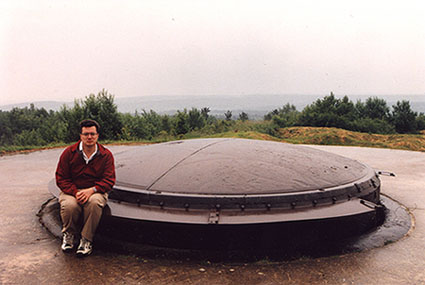
The author with Ft. Douaumont's 155mm gun turret.
The fort was originally formidably armed. Near the east end was the largest weapon in the fort, a single 155mm gun in a retractable turret. The gun was hinged at the front end and completely enclosed in the turret, leaving no vulnerable protruding barrel. The turret could be lowered into the fort for complete protection. It was counterweighted so two men could perform this operation. This, like the rest of the fort, proved all but invulnerable to the heaviest artillery used in the Great War. In the center of the fort was a twin 75mm retractable turret, basically a smaller version of the 155mm system.
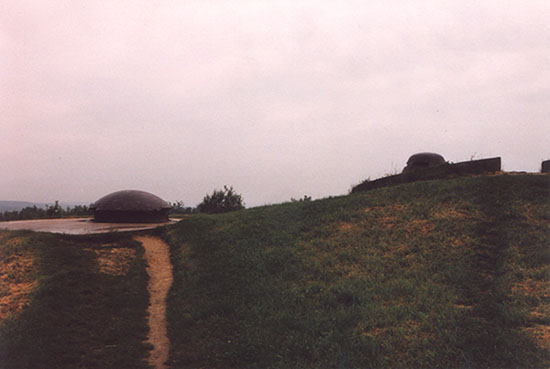
Ft. Douaumont's 75mm turret and an observation dome.
Also on the roof were two or three pop-up machine-gun cupolas, and several thick observation domes, with narrow vision slits so the enemy could be targeted.
At the rear corners of the pentagon, facing forward and outward, were the "casemates de Bourges". These held three 75mm guns each in a staggered arrangement, for flank protection. Down in the ditch, at each corner, were the counterscarp casemates. These were large pillboxes built into the outer wall of the ditch, holding 37mm revolver-cannon and machine guns to defeat any enemy therein. The casemates were accessed by tunnels which descended under the ditch. Branching off of these tunnels were listening tunnels, used to detect enemy attempts to undermine the fort.
Fort Vaux was significantly smaller, but of the same general plan. It was trapezoidal in shape, with the narrow side toward the enemy. The heaviest armament was a twin 75mm turret in the center. The "casemates de Bourges" held only two guns each. The machine-gun cupolas, observation domes, and counterscarp casemates were similar to Fort Douaumont's.
Part II - Fort Douaumont (I)
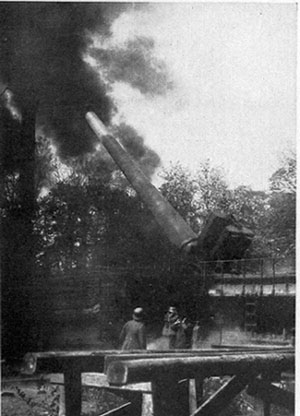
German 380mm gun firing.
The Battle of Verdun began on February 6, 1916 when a tremendous blast from a German 380mm battleship-type gun hit the courtyard of the Bishop's Palace, damaging the Cathedral. Fortunately, civilians had already been evacuated from the entire Verdun area. This hit was followed by the largest bombardment the world had yet seen, concentrated on the three French divisions guarding the Right Bank. Although he had ten divisions opposing them, General Eric von Falkenhayn, commander-in-chief of the German Armed Forces, was leaving nothing to chance. It appears from his proposal to the Kaiser outlining the Verdun plan that he intended to bleed France white. He would attack, but not capture, Verdun.
On the map, Verdun was a slight salient at the northeast corner of the French lines. Its abandonment would have meant the loss of a significant amount of French territory, plus a historic and well-fortified city of great sentimental value (although I haven't been able to find out what the reason for the sentimental value was). Thus, the French would exert great efforts to hold it, pouring troops into Falkenhayn's "zone of death" (his words for what the initial bombardment was to achieve). By limiting the use of infantry in his attacks, Falkenhayn calculated that he could kill three Frenchmen for every German lost. In this, he proved over-optimistic.
The German force at Verdun was the Fifth Army, commanded by the Crown Prince, eldest son of the Kaiser. His Chief of Staff was General Schmidt von Knobelsdorf. In a typically German arrangement, the Chief of Staff exercised most of the real power, with the Crown Prince being largely a figurehead.
The French divisions at the front were shattered by the bombardment before even seeing a German. The Germans walked into what they believed would be an area with no living enemies. But some Frenchmen survived. Their heroic resistance put the Germans off-balance, buying crucial time for reserves to be moved up to Verdun.
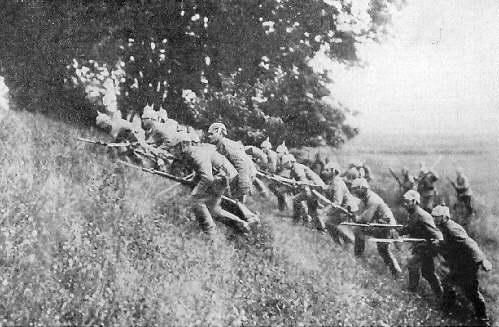
On the first day of Verdun, the Germans also took the opportunity to introduce to the world their new secret weapon, the flamethrower. They attacked southward, facing the north side of the French Right Bank position. As the battle developed, they found themselves having to fight off small, suicidal French assaults at every turn.
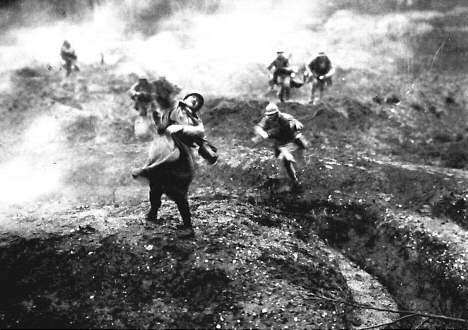
For the French army had no defensive doctrine as such. Their officers' only authorized response to an attack was a counter-attack, no matter the odds. This often put the Germans in some disarray, but greatly increased French casualties.
The forts of Verdun were in a sorry state to meet an attack. It had been assumed by the French high command that the era of fixed defenses was over, and the forts had been treated accordingly. They had been stripped of all armament save the turret guns, whose unique construction precluded their use in other roles. No machine guns, no revolver-cannon remained. Their garrisons were mostly middle-aged reservists, under the command of the city's military governor and not the field army. Although Fort Douaumont had only about 40 men in it, a few weeks prior to the battle the fort's commander had refused reinforcement from the regulars.
Back to The Fort Page.